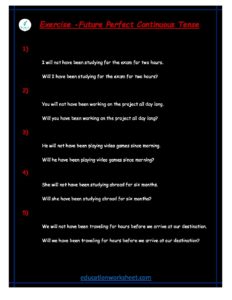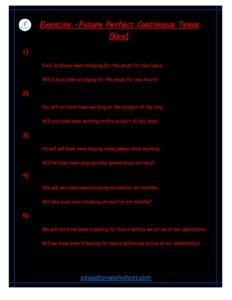Perfect Continuous examples
Perfect Continuous examples
Structure of the Present Perfect Continuous Tense:
To form the present perfect continuous tense, you need two main components: the auxiliary verb “have” (in the present tense) and the auxiliary verb “been.” After these auxiliary verbs, you will use the base form of the main verb, which is the present participle form (verb + -ing).
The general structure of the present perfect continuous tense is as follows:
Here are some examples of how this structure is applied:
- I have been studying for hours.
- She has been working at the company for five years.
- They have been playing soccer since morning.
Use of the Present Perfect Continuous Tense:

The present perfect continuous tense is primarily used to convey the idea of an action or situation that started in the past and has continued into the present. This tense emphasizes the duration or ongoing nature of the action. Here are the main situations where the present perfect continuous tense is used:
- Action Started in the Past, Continuing into the Present: This is the most common use of the present perfect continuous tense. It is used to describe actions or activities that started at some point in the past and are still ongoing at the time of speaking.
- I have been living in this city for three years.
- She has been working on the project all week.
- Actions That May or May Not Continue into the Future: The present perfect continuous can also suggest that an action or situation may or may not continue into the future, depending on the context.
- They have been looking for a new house. (This indicates an ongoing search that may continue.)
- I have been learning French. (This may imply that the learning will continue or has some relevance in the future.)
- Emphasizing Duration: This tense is often used when you want to emphasize the duration of an action or the effort put into it.
- He has been exercising for an hour.
- She has been studying tirelessly for the exam.
- Temporary Situations: Sometimes, the present perfect continuous tense is used to describe temporary or changing situations.
- It has been raining all day.
- He has been feeling unwell recently.
- Expressing Irritation or Annoyance: The present perfect continuous tense can be used to express irritation or annoyance about an action that has been ongoing for some time.
- They have been making noise all night.
- She has been talking on the phone for hours.
Perfect Continuous examples

Examples and Insights:
To gain a deeper understanding of the present perfect continuous tense, let’s explore a variety of examples that illustrate its use in different contexts.
- Ongoing Actions:
- I have been reading this book for weeks. (The action of reading began in the past and continues into the present.)
- They have been renovating their house for months. (The renovation project started some time ago and is still in progress.)
- Temporary States:
- The kids have been playing in the garden all afternoon. (The children are currently playing, and this is a temporary situation.)
- She has been cooking dinner for the family. (This indicates that she is in the process of cooking dinner, which will likely end when the meal is ready.)
- Emphasizing Duration:
- He has been watching that movie marathon for six hours. (This emphasizes the long duration of the movie-watching.)
- We have been waiting for the bus for ages. (The wait has been lengthy.)
- Future Implications:
- She has been learning to play the piano. (This suggests that her piano lessons will likely continue in the future.)
- They have been working on a new project. (This action is ongoing, and it may have future implications, such as completing the project.)
- Expressing Annoyance:
- They have been playing loud music all evening. (This can convey irritation about the ongoing loud music.)
- He has been talking on the phone for hours, and it’s getting on my nerves. (Expressing annoyance about the lengthy phone conversation.)
- Temporary Conditions:
- It has been snowing all morning. (This indicates that the snowfall is a temporary weather condition.)
- She has been feeling a bit under the weather lately. (Her feeling unwell is temporary or recent.)
- Habitual Actions:
- He has been jogging every morning. (This suggests that jogging is a regular or habitual activity for him.)
- She has been practicing the piano regularly. (The continuous aspect highlights the consistency of her practice.)
- Recent Past Actions:
- They have been playing cards all night. (This indicates that the card game took place throughout the night, leading up to the present.)
- I have been cleaning the house since this morning. (The cleaning activity started in the morning and is ongoing.)
Perfect Continuous examples


